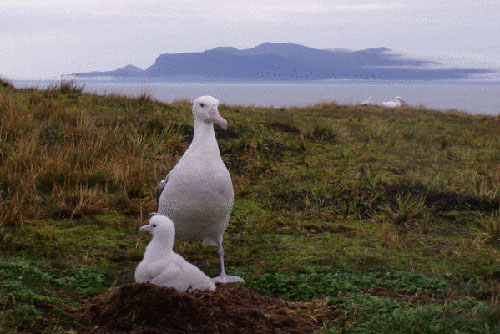The Prince Edward Islands, made up of the two sub-Antarctic islands of Marion and Prince Edward, are South Africa's only overseas possessions. Declared a Special Nature Reserve in 1995, South Africa's highest level of protection, and a Ramsar Wetland of International Importance (the first in the sub-Antarctic) in 2009, the island group contains significant populations of nine species of ACAP-listed albatrosses and petrels. Notably, the two islands combine support a little over 40% of the global population of the Vulnerable Wandering Albatross Diomedea exulans.

A breeding Wandering Albatross on Marion Island, with Prince Edward Island in the background
Prince Edward Island is uninhabited and is only visited at long intervals by small research groups because of its near-pristine nature (for example it supports only three species of alien plants and has never suffered from the presence of introduced mammals).
In contrast, the larger Marion Island supports a weather and research station, with a team of around 20 overwinterers who are replaced annually. Marion is overrun by introduced House Mice Mus musculus (which have been reported attacking Wandering Albatross chicks - click here) and a number of alien plant species, several of which are invasive and continue to spread around the island.
Up to now conservation activities at Marion Island outside the three-week relief period each April have been undertaken as an extra duty by an overwintering field researcher. This procedure has severely limited the amount of time available and has meant that the incumbent has not always had the required experience and training for the tasks at hand.
This less than satisfactory situation has now changed and from the 2012 relief, and for the first time in over 60 years of unbroken occupation, a full-time Team Environmental Control Officer (TECO) appointed by the South African Department of Environmental Affairs will spend a year on the island, supported by an assistant, as part of Marion's 69th Expedition.
Priority tasks to be undertaken in 2012/13 will be centred on the attempted eradication of four species of alien plants with still-restricted ranges, as well as ensuring adequate biosecurity procedures remain in place to halt the arrival of new aliens to the island. Other tasks include monitoring and mitigating against nocturnal bird strikes on the base buildings and at field huts, continuing with the island's long on-going "country clean-up" campaign of removing rubble and waste materials from the field, instituting a waste-stream procedure that will allow for recycling back in South Africa, monitoring and removing beach debris, and recording entanglements of both birds and seals.
Jacqueline Davis has been appointed as Marion's first TECO, with Zandile Simama as her assistant. Jacqui has previously spent two years on the island conducting geomorphological research towards her MSc and thus knows it well. With a new management plan completed and now awaiting only formal adoption by the Minister of Environmental Affairs, along with two conservation officers on the ground, it is expected that the Prince Edward Islands will continue to be well conserved.

Jacqui Davis, Floid Chauke (Relief Environmental Control Officer) and Zandile Simama inspect expeditioners' boots and clothing for alien propagules aboard ship the day before reaching the island

Jacqui scrubs her footwear in a solution of the anti-bacterial disinfectant Virkon S as part of the compulsory onboard "Boot-washing Ceremony", originally copied from the Australian Antarctic Division in the mid 1990s.
All photographs by John Cooper
Selected References:
Curry, C.H., McCarthy, J.S., Darragh, H.M., Wake, R.A., Churchill, S.E., Robins, A.M., & Lowrens, R.J. Identification of an agent suitable for disinfecting boots of visitors to the Antarctic. Polar Record 41 (216): 39-45.
Jones, M.G.W. & Ryan, P.G. 2010. Evidence of mouse attacks on albatross chicks on sub-Antarctic Marion Island. Antarctic Science 22: 39-42.
John Cooper, ACAP Information Officer, 19 April 2012 (at Marion Island)

 Français
Français  English
English  Español
Español